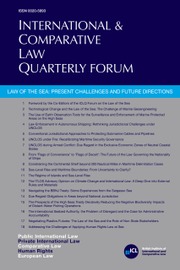With its focus on the three regional human rights courts, this book makes a valuable contribution to the corpus of knowledge on human rights. Originally published in French (2020, Pedone Editions), the text has been updated and carefully translated, in cooperation with the author, to ensure the meaning of the French original is preserved. It contributes to the existing human rights scholarship by going beyond the more typical approaches of examining one or comparing two of the regional systems.
Methodologically, Burgorgue-Larsen, a professor of public law at the University of Paris, relies on a socio-legal interdisciplinary and comparative approach that embeds the law within its historical and geopolitical contexts. Focusing on the three jurisdictional mechanisms created expressly to protect human rights in Europe, the Americas and Africa, the book explores their creation, evolution, textual interpretation and application. Underlying this focus is the question of how State sovereignty shapes ‘the obligation to protect the majesty of rights’.
This substantial tome addresses that question over seven chapters, an introduction and a conclusion. The introduction sets the scene for the subsequent comparative socio-legal analysis by explaining its focus, its aim and its context, and is supplemented by the introductory sections to each of the three main parts of the book. Chapter 1 provides an historical overview that draws together the various geopolitical and ‘legal diplomacy’ strands that the author argues were crucial to the creation of the three regional systems. It first explicates the geopolitical origins of the three regional courts, before examining the role of individuals such as Pierre-Henri Teitgen in Europe and Kéba Mbaye in Africa, and institutions such as the Inter-American Juridical Committee in the Americas and the International Commission of Jurists in Africa.
Consistent with the aim of the analysis, the book is divided into three parts. Part 1 focuses on the evolution of the three human rights courts within the context of their respective regional systems and the ‘external legal policies of the states’. It analyses the efficacy of human rights protection and its dependence on the political will of the States. Using specific examples as illustrations, States’ commitment to the regional protection of human rights through the universalisation and judicialisation of the systems within their respective regions is examined. The analysis then turns to the institutional nature of the systems and the differences between the European system that has granted exclusive jurisdiction to the Court, and the Inter-American and African systems that maintain a jurisdiction shared between the Court and Commission. The ongoing challenge of legitimacy is then highlighted, with an analysis of the choice of rights, given the ‘uneven levels of commitment’ to their protection, and of the selection of judges, which still affords the States the opportunity to use the process to further their sovereign interests.
Part 2 of the book compares the approaches of the three systems to the interpretation of their reference texts through decompartmentalisation—i.e. the use of external sources as an aid to interpretation. First, the evidence for the courts’ reliance on decompartmentalisation is set out, distinguishing the more ‘rebellious’ approaches of the European and Inter-American Courts from the more conservatively ‘faithful’ approach of the African Court. Then the impact of decompartmentalisation on the protection of rights is explored, explaining how it has led to an increased protection of human rights and convergence between the three courts. It then addresses the challenges faced by the courts from the States whose sovereignty has been impacted, from conservative non-governmental organisations, and from judges within the courts.
Part 3 of the book examines the application of regional human rights law by States. Two incentives for effective implementation are analysed: the ‘openness of national constitutions to international human rights law’; and the dialogue between the regional courts and both the national courts and the civic stakeholders. The more pragmatic issue of ensuring the effective implementation of judgments through regional controls and the commitment of national governments is then addressed. The book ends with a concluding chapter that draws together the analysis to highlight the impressive record of the three courts in the development of human rights standards. It also looks to the future and cautions about the threat posed by the regressive politics of populism and authoritarianism.
Overall, the book is coherent and well written, presenting convincing analyses that are easy to follow and provide useful insights into the creation, evolution and impact of the three courts within the context of their respective regional system. As a comparative, interdisciplinary and socio-legal analysis, this is an ambitious book that generally succeeds in its aim. The tripartite comparative approach ensures that the book is a valuable addition to the literature. Although the book does not identify its target audience, it should have cross-disciplinary appeal to practitioners, academics and advanced students with an interest in human rights. While the book is a valuable and welcome addition to the literature, its emphasis on the empirical rather than the normative is a limiting factor. However, the scope of the analysis is impressive, and provides a wealth of insights that should act as springboards for future research.


